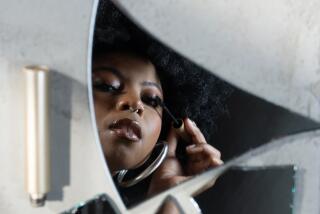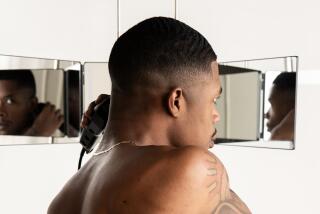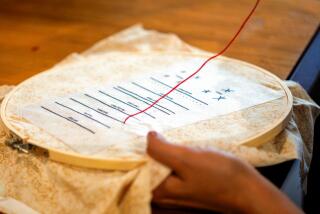Believers in Search of Piercing Insight
- Share via
Here we are at the end of a century of scientific and technological advances so vast they may surpass the rest of humankind’s history of knowledge--and cutting-edge culture has some of us looking like tribal nomads ready to take some heads: barbells in our eyebrows. Studs in our chins. Hoops in our genitalia.
Many in California--this holy mecca of holes--say they pierce their bodies to fully realize their individuality. The body’s landscape--for so long adorned with T-shirts-as-billboards and clothing-labels-as-advertisements--becomes their own. Piercing is a return to flesh as fashion--and a revitalized rite of passage.
“If someone’s under 18, it’s normal behavior to get pierced,” asserts pop culture expert Stuart Ewen. “It’s when I see 50-year-old guys at the gym with nipple rings that I start to worry.”
Indeed, there isn’t much progressive about piercing anymore. Not when your yuppie uncle has enough hoops in his body to set off airport security. And not when state lawmakers are trying to make a note from Mom mandatory for under-18 piercing.
So what is a fashion-wary West Coaster to do?
Not to worry. There are youth cults busy at work devising new ways to anger parents and subvert the mainstream’s black hole.
The cutting edge of piercing’s “modern primitive” movement can be found at Nomad Body Piercing Studio in San Francisco. The shop specializes in tribal and ancient piercings such as stretched-out lip holes (piercing the lower lip and stretching the hole), large septum jewelry and low-hanging earlobes.
The term “modern primitive” was coined by Fakir Musafar, a ‘70s pioneer of body modification who now publishes Body Play magazine. The phenomenon took off in 1989 with the publication of “Modern Primitives” (Re/Search), a book that featured photos of ancient and modern body art.
“It’s a rejection of the modern aesthetic,” says Nomad owner Kristian White. “Your body is yours. It’s the one thing you have to express yourself with.”
Extreme piercing can be found in underground pagan and gothic cults, too--sets that hang at L.A. nightclubs such as Sin-a-matic, Stigmata and Coven 13. Reports also abound of underground parties where piercing is performed and rites of pain are demonstrated as performance art.
Sexual piercings are the rage in L.A. body art, from the male Prince Albert (apparently, the old chap had a genital piercing--in Victorian times, no less) to the unisex nipple ring. Body Modification E-Zine, an online magazine, surveyed readers and found that half had their nipples pierced.
“It’s a freaky subculture of people,” says West Hollywood piercer Jennifer “Jeff” Middleton, who has square chrome hair, several piercings in her ears and one in her nose.
Earlier in the day, she was putting on latex gloves and preparing sterile instruments in a bright, clean second-floor room at the Gauntlet in West Hollywood. Customer Brian Lee had hoops in both ears and a tattoo on his back, so he felt the need to distinguish himself--with a pierced brow. “You want to show off what you’re about,” he said.
It took only about five minutes for Middleton to clean Lee’s right eyebrow, mark it, pinch it with forceps and poke an ultra-sharp, inch-long needle through his skin: $30 please. Lee didn’t flinch. Middleton explained the eight weeks of tedious healing and cleaning, but Lee just looked in the mirror and smiled when he saw the “barbell” protruding from his head.
“It does get trendy,” said Lee, a 22-year-old club deejay. “But there will always be a new body part to be pierced.”
Culture watchers say there is something deeper going on here. The Nomad studio’s White says organized religion has relinquished its grip on the minds and bodies of youth so that they may go back to pre-Christian rituals. And professor Ewen, chair of media studies at Hunter College in New York, says it is indeed a rejection of the neat, sleek, modern fashion aesthetic.
“This was a culture that was sold on the idea of progress since the turn of the century--clean lines, industrial aesthetic, mass-produced clothes,” he says. “There’s a sense of meaninglessness in this, so there’s a search for meaning--a belief that other ways of life might have more authenticity than ours.”
It is said that Roman warriors pierced body parts to show how tough they were, while Victorian women, otherwise notoriously chaste, pierced their nipples in acts of sensuality. Body modification has also been a staple of non-Western cultures for thousands of years.
But today, as teens and twentysomethings try to stand out, they face the paradox of modern subculture: More people want it, more people want to make money off it, and rebellion becomes a uniform instead of a torch of individuality.
“Body art was an embrace against the packaged self,” Ewen says. “Yet any attempt to marginalize one’s self provides new grist for the style industries.
“The only way to battle it is to find an ideal and stick with it. At that point, you kill off the consumption process. My only solution is to buy five pairs of pants and five sweaters and never wear anything else.”
Now that’s a radical concept.






